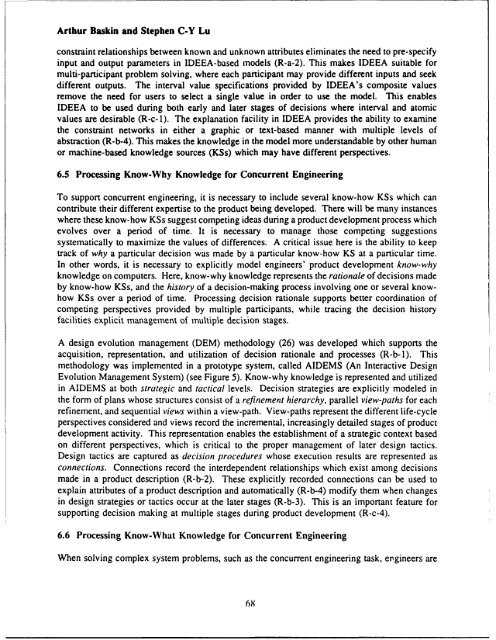Challenges and Opportunities for Innovation in the Public Works ...
Challenges and Opportunities for Innovation in the Public Works ...
Challenges and Opportunities for Innovation in the Public Works ...
Create successful ePaper yourself
Turn your PDF publications into a flip-book with our unique Google optimized e-Paper software.
Arthur Bask<strong>in</strong> <strong>and</strong> Stephen C-Y Lu<br />
constra<strong>in</strong>t relationships between known <strong>and</strong> unknown attributes elim<strong>in</strong>ates <strong>the</strong> need to pre-specify<br />
<strong>in</strong>put <strong>and</strong> output parameters <strong>in</strong> IDEEA-based models (R-a-2). This makes IDEEA suitable <strong>for</strong><br />
multi-participant problem solv<strong>in</strong>g, where each participant may provide different <strong>in</strong>puts <strong>and</strong> seek<br />
different outputs. The <strong>in</strong>terval value specifications provided by IDEEA's composite values<br />
remove <strong>the</strong> need <strong>for</strong> users to select a s<strong>in</strong>gle value <strong>in</strong> order to use <strong>the</strong> model. This enables<br />
IDEEA to be used dur<strong>in</strong>g both early <strong>and</strong> later stages of decisions where <strong>in</strong>terval <strong>and</strong> atomic<br />
values are desirable (R-c-1). The explanation facility <strong>in</strong> IDEEA provides <strong>the</strong> ability to exam<strong>in</strong>e<br />
<strong>the</strong> constra<strong>in</strong>t networks <strong>in</strong> ei<strong>the</strong>r a graphic or text-based manner with multiple levels of<br />
abstraction (R-b-4). This makes <strong>the</strong> knowledge <strong>in</strong> <strong>the</strong> model more underst<strong>and</strong>able by o<strong>the</strong>r human<br />
or mach<strong>in</strong>e-based knowledge sources (KSs) which may have different perspectives.<br />
6.5 Process<strong>in</strong>g Know-Why Knowledge <strong>for</strong> Concurrent Eng<strong>in</strong>eer<strong>in</strong>g<br />
To support concurrent eng<strong>in</strong>eer<strong>in</strong>g, it is necessary to <strong>in</strong>clude several know-how KSs which can<br />
contribute <strong>the</strong>ir different expertise to <strong>the</strong> product be<strong>in</strong>g developed. There will be many <strong>in</strong>stances<br />
where <strong>the</strong>se know-how KSs suggest compet<strong>in</strong>g ideas dur<strong>in</strong>g a product development process which<br />
evolves over a period of time. It is necessary to manage those compet<strong>in</strong>g suggestions<br />
systematically to maximize <strong>the</strong> values of differences. A critical issue here is <strong>the</strong> ability to keep<br />
track of why a particular decision was made by a particular know-how KS at a particular time.<br />
In o<strong>the</strong>r words, it is necessary to explicitly model eng<strong>in</strong>eers' product development know-why<br />
knowledge on computers. Here, know-why knowledge represents <strong>the</strong> rationale of decisions made<br />
by know-how KSs, <strong>and</strong> <strong>the</strong> history of a decision-mak<strong>in</strong>g process <strong>in</strong>volv<strong>in</strong>g one or several knowhow<br />
KSs over a period of time. Process<strong>in</strong>g decision rationale supports better coord<strong>in</strong>ation of<br />
compet<strong>in</strong>g perspectives provided by multiple participants, while trac<strong>in</strong>g <strong>the</strong> decision history<br />
facilities explicit management of multiple decision stages.<br />
A design evolution management (DEM) methodology (26) was developed which supports <strong>the</strong><br />
acquisition, representation, <strong>and</strong> utilization of decision rationale <strong>and</strong> processes (R-b-l). This<br />
methodology was implemented <strong>in</strong> a prototype system, called AIDEMS (An Interactive Design<br />
Evolution Management System) (see Figure 5). Know-why knowledge is represented <strong>and</strong> utilized<br />
<strong>in</strong> AIDEMS at both strategic <strong>and</strong> tactical levels. Decision strategies are explicitly modeled <strong>in</strong><br />
<strong>the</strong> <strong>for</strong>m of plans whose structures consist of a ref<strong>in</strong>ement hierarchy, parallel view-paths <strong>for</strong> each<br />
ref<strong>in</strong>ement, <strong>and</strong> sequential views with<strong>in</strong> a view-path. View-paths represent <strong>the</strong> different life-cycle<br />
perspectives considered <strong>and</strong> views record <strong>the</strong> <strong>in</strong>cremental, <strong>in</strong>creas<strong>in</strong>gly detailed stages of product<br />
development activity. This representation enables <strong>the</strong> establishment of a strategic context based<br />
on different perspectives, which is critical to <strong>the</strong> proper management of later design tactics.<br />
Design tactics are captured as decision procedures whose execution results are represented as<br />
connections. Connections record <strong>the</strong> <strong>in</strong>terdependent relationships which exist among decisions<br />
made <strong>in</strong> a product description (R-b-2). These explicitly recorded connections can be used to<br />
expla<strong>in</strong> attributes of a product description <strong>and</strong> automatically (R-b-4) modify <strong>the</strong>m when changes<br />
<strong>in</strong> design strategies or tactics occur at <strong>the</strong> later stages (R-b-3). This is an important feature <strong>for</strong><br />
support<strong>in</strong>g decision mak<strong>in</strong>g at multiple stages dur<strong>in</strong>g product development (R-c-4).<br />
6.6 Process<strong>in</strong>g Know-What Knowledge <strong>for</strong> Concurrent Eng<strong>in</strong>eer<strong>in</strong>g<br />
When solv<strong>in</strong>g complex system problems, such as <strong>the</strong> concurrent eng<strong>in</strong>eer<strong>in</strong>g task, eng<strong>in</strong>eers are<br />
68







